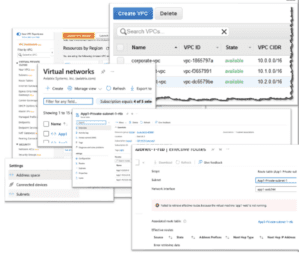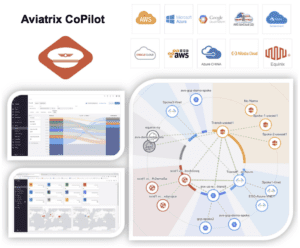As businesses increasingly rely on cloud technologies, they choose platforms that are best for their specific needs irrespective of the cloud provider – often resulting in using two or more public clouds. The desire to stay cloud-native results in two, three, four different cloud provider-specific cloud-native architectures that then need to be stitched together and operationalized by enterprise IT teams. The resulting underlying network architecture and operations required to support this approach have become exceedingly complex.
According to Enterprise Management, two-thirds of enterprises rely on six or more tools to manage, monitor, and troubleshoot their networks. IT teams now need to deal with these diverse tools and capabilities, managed by often siloed teams, multiple transit and hub configurations, and inconsistent telemetry. In addition to cloud native tools, IT also must account for legacy devices in colos, data centers, and edge locations that connect to public clouds.
This adds to the problem, often referred to as a “sprawl of consoles.”

The Business Bottom Line is on the Line
The result of a sprawl of consoles is that it’s difficult to troubleshoot problems quickly, more people are required to be involved, and IT is unable to provide executives with a consolidated view and report of the network – because no one knows the entire traffic path or how many people need to be involved in it. Time and resources are poured into the network with little understanding of – or insight into – how to optimize it.
Furthermore, there’s no longer a single “throat to choke” when something goes wrong. The IT team has to work with different providers and become the intermediary to solve any problem. Networking-related problems have been the single biggest cause of all IT service downtime incidents over the past three years (Uptime Institute), and the average business can expect a downtime cost of $5,600 per minute (GlobalDots). Companies need to reduce mean time to recover (MTTR) and mean time to identify (MTTI) issues in order to maximize uptime.
Unfortunately, a basic combination of CSP native tools and traditional networking tools can’t meet these requirements, as they don’t provide consistent experience, features, or integrations.
Inside the Technical Trenches
For technical teams, the challenges of managing cloud networks are numerous. Each transit or hub needs to be individually configured, managed, and troubleshot, leading to operational complexity. Additionally, the lack of a consolidated dashboard and telemetry makes it nearly impossible to gain a complete view of the network. The lack of consistency and capabilities across tools that are used further complicates the situation.
Imagine, for instance, a P1 incident where you are sitting on a call and the CTO asks to do basic troubleshooting like ping or packet capture from cloud to on-prem. It’s a seemingly simple ask, but you can’t fulfill it since the feature is only available on-prem – not in cloud. You need to pull data from five different places manually to analyze, and you may not have access to all those five resources – which means waiting for someone else to get it for you.
IT professionals find themselves all too often under pressure to deliver results or solutions, but without the resources to respond to even seemingly simple asks.
“I provide fast troubleshooting and low SLA for my data center network because I have the visibility and tools available. The business wants me to provide even better SLAs in cloud, but I don’t have the tools and visibility in cloud that enables me to offer the service in the data center” – Sr. Network Engineer, Food & Beverage Industry
Secure Cloud Network Backbone
Fortunately, Aviatrix offers a solution that addresses these challenges head-on. By consolidating networking of all the individual control, management, data, and operational planes into one solution, Aviatrix provides a consistent experience, features, and integrations. This means that businesses can have a complete view of their cloud network backbone, irrespective of region, cloud, or edge location.
Using the Aviatrix Secure Cloud Network Backbone, which provides the same operational tooling and advanced capabilities irrespective of cloud provider, edge, colo or data center location, businesses can reduce MTTR/MTTI and increase uptime. Aviatrix also requires less time and resources, making it easier for IT teams to manage networks. Aviatrix’s consolidated dashboard and telemetry offer a complete view of the network, enabling executives to get a clear picture of the network’s health and performance.

“Aviatrix allows us to quickly onboard other public clouds…and avoid the time of using very proprietary tools from each of these cloud vendors,” said David Van Damme, Vice President of Digital Technology, Americas, at Yara International, a 120-year-old global crop nutrition company. In addition to advanced capabilities, Aviatrix’s solution provided a consistent experience and eliminated the need for multiple tools.
If you’re looking for more information about this problem and various ways to solve it, Aviatrix’s one-day ACE Operations certification program is a great resource. Its training helps network operations center (NOC) teams learn how to troubleshoot and operationalize cloud infrastructures, bridging the skills gap in a very short time.
Looking for more advice on tackling the sprawl of consoles problem? Wondering what other common challenges enterprises frequently encounter with cloud networking and security (and how to avoid them)? Download our Ebook and get practical steps for turning your cloud network into the business enabler it was always meant to be.
Scan this QR code to get in touch now:



